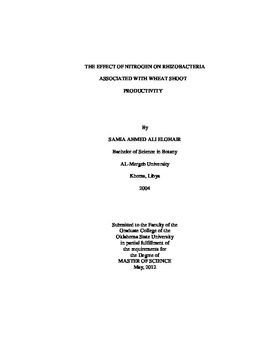| dc.contributor.advisor | Anderson, Michael P. | |
| dc.contributor.author | Elghair, Samia Ahmed Ali | |
| dc.date.accessioned | 2014-04-15T22:06:00Z | |
| dc.date.available | 2014-04-15T22:06:00Z | |
| dc.date.issued | 2012-05-01 | |
| dc.identifier.uri | https://hdl.handle.net/11244/9319 | |
| dc.description.abstract | The effect of nitrogen fertilizer on rhizobacteria associated with wheat (Triticum aestivum) shoot productivity was determined by using pyrosequencing technique. Easpur Loam soils was treated with 112-kg/ha N or left untreated at 39.3-kg/ha N using urea as a nitrogen source and 96 plants per N treatment. Plant rhizospheres were categorized according to corresponding shoot weights resulting in four treatment combinations based upon with and without nitrogen and high and low productivity classifications. Two factor ANOVA was used to identify operational taxonomic units (OTUs) with significant association with either nitrogen or productivity. A total of 94 OTUs were significantly associated with productivity and/or nitrogen treatment. Of these, 49 were associated with wheat grown under nitrogen application, 4 without nitrogen application, 20 with high shoot biomass, and 21 with low shoot biomass. Gemmatimonadetes, Acidobacteria, Proteobacteria, and Bacteroidetes were the most common phyla associated with wheat productivity when supplemented with nitrogen fertilizer. Of the bacterial groups evaluated, Actinobacteria was the most common phylum, and Laceyella #35239 and Marmoricola #46721 were the most significant OTUs associated with high biomass plant. The most significant OTUs associated with low biomass plants were Firmicutes #48486 Actinobacteria #38639, Rhodospirillaceae #50459, Sporichthya #51614, Hyphomicrobiaceae #50895, Ensifer #29687, and Micromonosporaceae #18302. Based on Chao1 rhizobacterial diversity was significantly greater in high biomass plants (P = 0.046) compared to low biomass plants. However, rhizobacteria diversity between nitrogen treatments was not significantly different according to Shannon and Chao1 indices. Data obtained from this study suggested that significant associations exist among rhizobacteria with respect to plant productivity and nitrogen addition. In the future, a better understanding of the relationships between the rhizobacteria community and wheat productivity may afford us opportunities to maximize wheat production by minimizing fertilizer inputs, resulting in increased economic returns for the producer. | |
| dc.format | application/pdf | |
| dc.language | en_US | |
| dc.publisher | Oklahoma State University | |
| dc.rights | Copyright is held by the author who has granted the Oklahoma State University Library the non-exclusive right to share this material in its institutional repository. Contact Digital Library Services at lib-dls@okstate.edu or 405-744-9161 for the permission policy on the use, reproduction or distribution of this material. | |
| dc.title | Effect of Nitrogen on Rhizobacteria Associated with Wheat Shoot Productivity | |
| dc.type | text | |
| dc.contributor.committeeMember | Deng, Shiping | |
| dc.contributor.committeeMember | Anderson, Jeffrey | |
| osu.filename | Elghair_okstate_0664M_12017.pdf | |
| osu.college | Agricultural Sciences and Natural Resources | |
| osu.accesstype | Open Access | |
| dc.description.department | Department of Plant and Soil Sciences | |
| dc.type.genre | Thesis | |
| dc.subject.keywords | nitrogen | |
| dc.subject.keywords | productivity | |
| dc.subject.keywords | pyrosequencing | |
| dc.subject.keywords | rhizobacteria | |
| dc.subject.keywords | wheat | |
